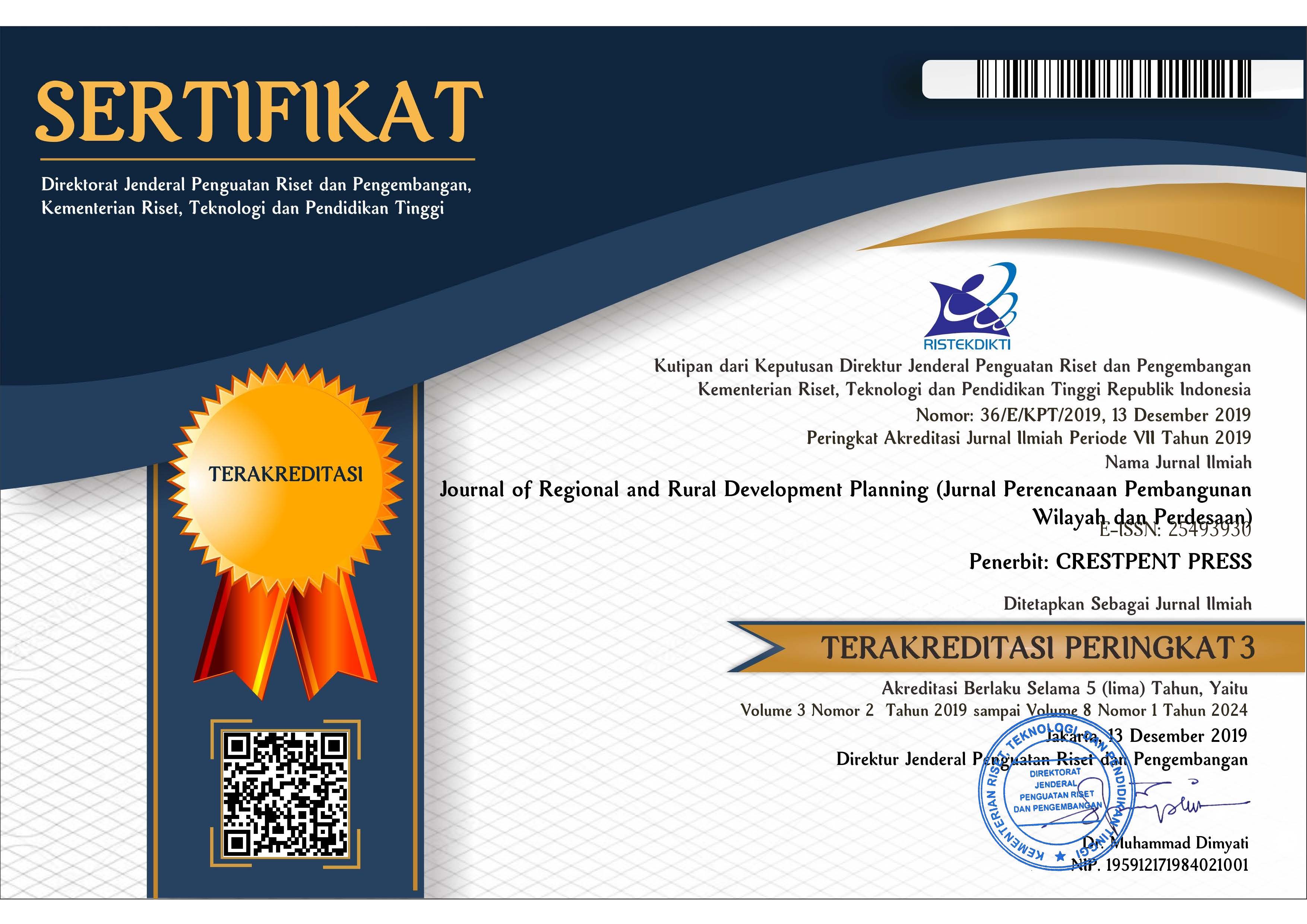Rural Transformation and Poverty Reduction in Rural Area
Abstract
Rural Development is a major concern of the Indonesian government and has grown rapidly in the last decade. However, the pattern of development and its correlation to poverty remains a question mark. Using the Difference in Difference estimation model we analyzed whether the economic transformation in the rural area that occurred in the period 2014 to 2018 correlated with a decline in rural poverty. This study utilized secondary data from the micro dataset referring to the smallest administrative level named Village Potential from the Central Bureau of Statistics in Indonesia. Disaggregated by the transformed sectors, this study shows that the strongest correlation to the decline in the number of rural poor occurs when agricultural dominant-based villages have been complemented by adequate or have transformed as well to the service sector and other sectors. While the transformation to the trade sector shows the right direction of the correlation that reflects the decline in the number of poor people, the effect is still not significant. Atypical result in the transportation sector and industrial sector has not reduced poverty.
References
Abadie, A. (2005). Difference-in-Differences Estimators Semiparametric. Review of Economic Studies, 72(1), 1–19.
Aggarwal, S. (2018). Do rural roads create pathways out of poverty? Evidence from India. Journal of Development Economics, 133(January), 375–395. https://doi.org/10.1016/j.jdeveco.2018.01.004
Aji, Y. I. T. (2021). Dana desa dan perkembangan status desa: studi kasus kabupaten/kota di indonesia tesis.
Arham, M. A., & Hatu, R. (2020). Does Village Fund Transfer Address the Issue of Inequality and Poverty? A Lesson from Indonesia*. Journal of Asian Finance, Economics and Business, 7(10), 433–442. https://doi.org/10.13106/jafeb.2020.vol7.no10.433
Arifin, B., Wicaksono, E., Tenrini, R. H., Wardhana, I. W., Setiawan, H., Damayanty, S. A., Solikin, A., Suhendra, M., Saputra, A. H., Ariutama, G. A., Djunedi, P., Rahman, A. B., & Handoko, R. (2020). Village fund, village-owned-enterprises, and employment: Evidence from Indonesia. Journal of Rural Studies, 79(September), 382–394. https://doi.org/10.1016/j.jrurstud.2020.08.052
Asher, S., & Novosad, P. (2015). Market Access and Structural Transformation: Evidence from Rural Roads in India. Working Paper.
Asher, S., & Novosad, P. (2017). Rural Roads and Structural Transformation ∗. Dartmouth.Edu, March 2013. http://www.dartmouth.edu/~novosad/asher-novosad-roads.pdf
Asian Development Bank. (2012). The Saemaul Undong Movement in the Republic of Korea: Sharing Knowledge on Community-Driven Development. In Agricultural History Studies (Vol. 5, Issue 2).
Bakht, Z. (2000). Poverty Impact of Rural Roads and Markets Improvement & Maintenance Project of Bangladesh. World Bank South Asia Poverty Monitoring and Evaluation Workshop, Journal Article, 39.
Belton, B., & Filipski, M. (2019). Rural transformation in central Myanmar: By how much, and for whom? Journal of Rural Studies, 67(June 2018), 166–176. https://doi.org/10.1016/j.jrurstud.2019.02.012
Berdegué, J. A., Rosada, T., & Bebbington, A. J. (2013). The Rural Transformation. Evolving Concepts of Development through the Experience of Developing Countries, 1–44.
Calderon, C., & Serven, L. (2010). Infrastructure and Economic Development in Sub-Saharan Africa. Journal of African Economies, 19(Supplement 1), i13–i87. https://doi.org/10.1093/jae/ejp022
Christiaensen, L., & Todo, Y. (2014). Poverty reduction during the rural-urban transformation - The role of the missing middle. World Development, 63, 43–58. https://doi.org/10.1016/j.worlddev.2013.10.002
Davis, B., Di Giuseppe, S., & Zezza, A. (2017). Are African households (not) leaving agriculture? Patterns of households’ income sources in rural Sub-Saharan Africa. Food Policy, 67, 153–174. https://doi.org/10.1016/j.foodpol.2016.09.018
Deininger, K., Jin, S., Xia, F., & Huang, J. (2014). Moving off the farm: Land institutions to facilitate structural transformation and agricultural productivity growth in China. World Development, 59, 505–520. https://doi.org/10.1016/j.worlddev.2013.10.009
Do, T. T., Nguyen, H. T. M., & Vu, T. T. (2016). A Comparative Study on the Self-help Approach in Rural Development between Vietnam’s New Rural Development and Korea’s Saemaul Undong. East Asian Economic Review, 20(1), 91–125. https://doi.org/10.11644/kiep.jeai.2016.20.1.306
Erwidodo, Dermoredjo, S. K., Yusuf, E. S., Purba, H. J., Rachmawati, R. R., & Sudaryanto, T. (2021). Rural and structural transformation and their impacts on household in East Java. IOP Conference Series: Earth and Environmental Science, 892(1), 1–9. https://doi.org/10.1088/1755-1315/892/1/012065
Fan, S., & Zhang, X. (2004). Infrastructure and regional economic development in rural China. China Economic Review, 15(2), 203–214. https://doi.org/10.1016/j.chieco.2004.03.001
Gibson, J., & Olivia, S. (2010). The effect of infrastructure access and quality on non-farm enterprises in rural Indonesia. World Development, 38(5), 717–726. https://doi.org/10.1016/j.worlddev.2009.11.010
Hans Antlöv, Anna Wetterberg, L. D. (2016). Village_Governance_Community_Life_FORAMO (pp. 1–23). https://doi.org/10.1080/00074910302013
Hulu, Y., Hamdani, R., Muhammad, H., & Nasution, A. (2018). Jurnal Pendidikan Ilmu-Ilmu Sosial Pengelolaan Dana Desa dalam Pemberdayaan Masyarakat Desa. 10(1), 146–154. http://jurnal.unimed.ac.id/2012/index.php/jupiis
Hwang, J., Park, J., & Lee, S. (2018). The impact of the Comprehensive Rural Village Development Program on rural sustainability in Korea. Sustainability (Switzerland), 10(7). https://doi.org/10.3390/su10072436
Imai, K. S., Gaiha, R., & Garbero, A. (2017). Poverty reduction during the rural–urban transformation: Rural development is still more important than rbanization. Journal of Policy Modeling, 39(6), 963–982. https://doi.org/10.1016/j.jpolmod.2017.10.002
Jacob, J. (2005). Late industrialization and structural change: Indonesia, 1975-2000. Oxford Development Studies, 33(3–4), 427–451. https://doi.org/10.1080/13600810500317820
Jamaluddin, Y., Sumaryana, A., Rusli, B., & Buchari, R. A. (2018). Analisis Dampak Pengelolaan dan Penggunaan Dana Desa terhadap Pembangunan Daerah. JPPUMA: Jurnal Ilmu Pemerintahan Dan Sosial Politik Universitas Medan Area, 6(1), 14. https://doi.org/10.31289/jppuma.v6i1.1520
Jayne, T. S., Haggblade, S., Minot, N., & Rashid, S. (2011). Agricultural Commercialization , Rural Transformation and Poverty Reduction : What have We Learned about How to Achieve This ?
Kamaludin, A. S., & Qibthiyyah, R. M. (forthcoming 2022). Village Road Quality and Accessibility on Transforming Rural Development.
Kyunghoon, K., Mungsunti, A., Sumner, A., & Yusuf, A. (2020). WIDER Working Paper 2020 / 36 Structural transformation and inclusive growth in Bangladesh (Issue March).
Lokshin, M., & Yemtsov, R. (2005). Has rural infrastructure rehabilitation in Georgia helped the poor? World Bank Economic Review, 19(2), 311–333. https://doi.org/10.1093/wber/lhi007
Majumdar, K. (2020). Rural Transformation in India: Deagrarianization and the Transition from a Farming to Non-farming Economy. Journal of Developing Societies, 36(2), 182–205. https://doi.org/10.1177/0169796X20912631
Mora, R., & Reggio, I. (2013). Treatment Effect Identification Using Alternative Parallel Assumptions. Universidad Carlos III de Madrid Working Papers, 12–33(November), 1–28.
Nakamura, S., Bundervoet, T., & Nuru, M. (2020). Rural Roads, Poverty, and Resilience: Evidence from Ethiopia. Journal of Development Studies, 56(10), 1838–1855. https://doi.org/10.1080/00220388.2020.1736282
Nasution, F. A., Erlina, & Rujiman. (2017). The Role of Village Funds to the Development Area in the Sub- District of West Bilah , Labuhanbatu Regency , North Sumatera , Indonesia. International Journal of Progressive Sciences and Technologies, 6(1), 221–227. https://ijpsat.ijsht-journals.org/index.php/ijpsat/article/view/224/116
Nguyen, T. A., Gillen, J., & Rigg, J. (2020). Economic transition without agrarian transformation: the pivotal place of smallholder rice farming in Vietnam’s modernisation. Journal of Rural Studies, 74(April 2019), 86–95. https://doi.org/10.1016/j.jrurstud.2019.12.008
Pemerintah Republik Indonesia. (2014). Undang-undang Nomor 6 Tahun 2014 tentang Desa (Issue 1).
Ramly, A. R., Wahyuddin, W., Mursyida, J., & Mawardati, M. (2018). The Implementation of Village Fund Policy in Improving Economy of Village Society. Jurnal Ilmiah Peuradeun, 6(3), 459. https://doi.org/10.26811/peuradeun.v6i3.184
Rammelt, C. F., & Leung, M. W. H. (2017). Tracing the Causal Loops Through Local Perceptions of Rural Road Impacts in Ethiopia. World Development, 95, 1–14. https://doi.org/10.1016/j.worlddev.2017.02.024
Ratnasari, A. (2020). Penyelenggaraan Pelayanan Surat. 8(4), 213–224.
Renkow, M., Hallstrom, D. G., & Karanja, D. D. (2004). Rural infrastructure, transactions costs and market participation in Kenya. Journal of Development Economics, 73(1), 349–367. https://doi.org/10.1016/j.jdeveco.2003.02.003
Shamdasani, Y. (2021). Rural road infrastructure & agricultural production: Evidence from India. Journal of Development Economics, 152(April), 102686. https://doi.org/10.1016/j.jdeveco.2021.102686
Siwu, A. L. (2016). Kinerja Aparat Desa Dalam Penyelenggaraan Pelayanan Surat Keterangan Tidak Mampu (Sktm) Di Desa Motoling I Kecamatan Motoling Kabupaten Minahasa Selatan. Jurnal Politico, 5(1), 1–20.
Sulila, I. (2019). An Analysis of the Effectiveness of Allocation of Village Fund Policy Implementation and Its Determining Factors in Gorontalo Regency. Jurnal Ilmiah Ilmu Administrasi Publik: Jurnal Pemikiran Dan Penelitian Administrasi Publik, 9(2), 67–78.
The World Bank. (2019). Indonesia - TA on Village Transfer: Policy Note on Redefining Village Expenditure Classification -Towards a Better Tracking of Village Spending (English). June, 46. http://documents.worldbank.org/curated/en/935921564028030541/Indonesia-TA-on-Village-Transfer-Policy-Note-on-Redefining-Village-Expenditure-Classification-Towards-a-Better-Tracking-of-Village-Spending
Timmer, c, P. (2009). A world without agriculture: The structural transformation in historical perspective. In The Henry Wendt Lectures Series. http://www.aei.org/wp-content/uploads/2014/06/-a-world-without-agriculture-the-structural-transformation-in-historical-perspective_145442400043.pdf
Timmer, P. (2015). Managing Structural Transformation (Issue October).
Todaro, M. P., & Smith, S. C. (2012). The Developed and Developing World Income.
United Nations. (2021). Reconsidering rural Development. In World Social Report.
World Bank. (2020). World Bank. 2020. Global Economic Prospects (Issue June). https://www.bancomundial.org/es/news/press-release/2020/06/08/covid-19-to-plunge-global-economy-into-worst-recession-since-world-war-ii
Copyright (c) 2023 Journal of Regional and Rural Development Planning (Jurnal Perencanaan Pembangunan Wilayah dan Perdesaan)

This work is licensed under a Creative Commons Attribution-ShareAlike 4.0 International License.




.png)














